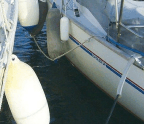THE PREPARATION, THE COST AND THE REALITY

As cruising sailors, many of us might not even contemplate taking part in an offshore yacht race, but the preparations made by the skippers participating in the MailASail AZAB 2019 provide important lessons for anyone planning to sail offshore. What kit do you really need for a safe passage? How much does it cost? How do you make your boat more seaworthy for heavy weather conditions? What do you need to plan for the longer offshore legs?
Since the inaugural AZAB in 1975, sponsored by Yachting Monthly, the Corinthian spirit of the race has endured, with seasoned racers who have previously made the passage from Falmouth to São Miguel’s Ponta Delgada and back happy to offer help, tips and advice to those taking part for the first time. It is in this spirit that four sailors, who were all racing doublehanded, share the highs and lows of this year’s event.
Volatile weather and constant headwinds made it one of the toughest competitions in recent memory, with two dismastings. Just 32 out of the 44 boats that crossed the start line made it back to Falmouth, having sailed a round trip of 2,500 miles.
HELENA LUCAS
WESTERLY OCEAN 33, SHUNA
Position in race: 3rd in Class 3 18th overall

Having retired from Paralympic sailing in 2016, I was in need of a new challenge. Keen for us to start having adventures together, it was my husband, Stephen, who suggested that we enter the MailASail AZAB 2019. He had previously competed in a 29ft Starlight half-tonner in 1987, finishing 3rd overall, and now, 32 years later, we were on the start line in Shuna.
The race was a challenge for me. Until 2018, when we competed in the Triangle Race, I had never been at sea for more than 24 hours. We wanted
You’re reading a preview, subscribe to read more.
Start your free 30 days





